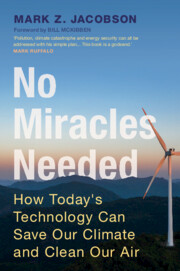Book contents
- No Miracles Needed
- Reviews
- No Miracles Needed
- Copyright page
- Dedication
- Contents
- Figures
- Foreword
- Preface
- 1 What Problems Are We Trying to Solve?
- 2 WWS Solutions for Electricity Generation
- 3 WWS Solutions for Electricity Storage
- 4 WWS Solutions for Transportation
- 5 WWS Solutions for Buildings
- 6 WWS Solutions for Industry
- 7 Solutions for Nonenergy Emissions
- 8 What Doesn’t Work
- 9 Electricity Grids
- 10 Photovoltaics and Solar Radiation
- 11 Onshore and Offshore Wind Energy
- 12 Steps in Developing 100 Percent WWS Roadmaps
- 13 Keeping the Grid Stable with 100 Percent WWS
- 14 Timeline and Policies Needed to Transition
- 15 My Journey
- References
- Index
5 - WWS Solutions for Buildings
Published online by Cambridge University Press: 02 February 2023
- No Miracles Needed
- Reviews
- No Miracles Needed
- Copyright page
- Dedication
- Contents
- Figures
- Foreword
- Preface
- 1 What Problems Are We Trying to Solve?
- 2 WWS Solutions for Electricity Generation
- 3 WWS Solutions for Electricity Storage
- 4 WWS Solutions for Transportation
- 5 WWS Solutions for Buildings
- 6 WWS Solutions for Industry
- 7 Solutions for Nonenergy Emissions
- 8 What Doesn’t Work
- 9 Electricity Grids
- 10 Photovoltaics and Solar Radiation
- 11 Onshore and Offshore Wind Energy
- 12 Steps in Developing 100 Percent WWS Roadmaps
- 13 Keeping the Grid Stable with 100 Percent WWS
- 14 Timeline and Policies Needed to Transition
- 15 My Journey
- References
- Index
Summary
In a 100 percent WWS world, air and water heating and air conditioning in buildings will be provided either by district heating and cooling systems or by individual heating and cooling systems. In both cases, heating and cooling will be provided primarily by electric heat pumps, where the electricity comes from WWS sources and the heat or cold is extracted from the air, ground, water, or a waste stream of hot or cold air or water. The heat and cold may be stored or used immediately. Additional heat may come from geothermal and solar heat. The remaining energy used in buildings is for electric appliances and gadgets, such as lights, televisions, computers, and phone chargers. This chapter discusses how WWS will power district and individual-building heating and cooling systems, including hot and cold storage options for both. It also discusses electric appliances and machines that will replace natural gas ones in buildings and their gardens. The chapter also examines energy efficiency in buildings and techniques to reduce building energy use. Finally, it discusses a modern district heating and cooling system and an all-electric home.
- Type
- Chapter
- Information
- No Miracles NeededHow Today's Technology Can Save Our Climate and Clean Our Air, pp. 78 - 108Publisher: Cambridge University PressPrint publication year: 2023



